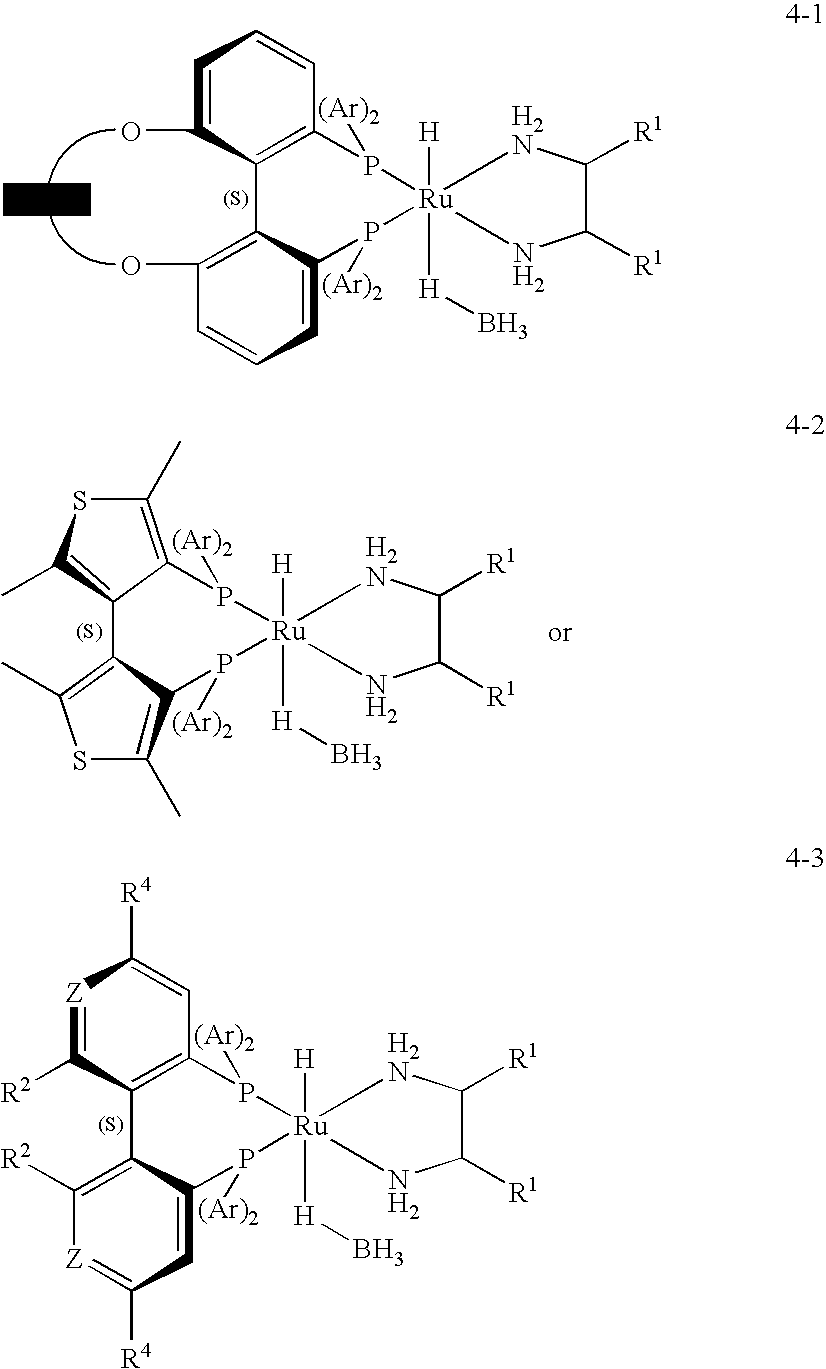Asymmetric hydrogenation of 1,1,1-trifluoroacetone
a trifluoroacetone and asymmetric technology, applied in the field of asymmetric hydrogenation of 1, 1, 1trifluoroacetone, can solve the problems of inapplicability to large-scale economic and social benefits, inability to meet the requirements of large-scale production, and inability to achieve large-scale economic benefits, high enantiomeric excess, and high chemical purity.
- Summary
- Abstract
- Description
- Claims
- Application Information
AI Technical Summary
Benefits of technology
Problems solved by technology
Method used
Image
Examples
examples 1-22
Example 1
(S)-1,1,1-Trifluoro-2-propanol
[0119]A 35-ml stainless steel autoclave was charged on air with 3.125 g of 1,1,1-trifluoroacetone (27.89 mmol), 3.16 mg of [RuCl2((S)-3,5-tBu-MeOBIPHEP)((R,R)-DPEN)] (2.23×10−6 mol, S / C 12,500), 0.80 mg of sodium formate (11.5×10−6 mol) and 0.100 g of water as additive. The autoclave was sealed and the hydrogenation was run under stirring at 40° C. and 40×105 Pa of hydrogen. After 20 h the autoclave was vented and opened. Crude product (2.970 g, incl. additive) with 99.2% ee and >99.9% purity was isolated as a yellowish oil. Bulb-to-bulb distillation of the crude product (oven temperature: r.t. to 130° C., 1 atm) afforded 86% (corrected) of the title compound (2.836 g, incl. additive) as a colorless oil with 99.2% ee and >99.9% purity.
[0120]1H NMR (300 MHz, CDCl3): 4.12 (qd, 1H, J=6.2, 6.1 Hz); 2.05 (d, 1H, J=6.1 Hz); 1.38 (d, 3H, J=6.2 Hz). GC method for the determination of purity and ee: Column: BGB-174 (30 m, I.D. 0.25 mm); oven: 60° C. (5 ...
example 1.2
(S)-1,1,1-Trifluoro-2-propanol
[0121]In analogy to Example 1, a 185-ml stainless steel autoclave was charged in the glove box with 0.75 ml of water (additive), 14.86 mg of [RuCl2((S)-3,5-tBu-MeOBIPHEP)((R,R)-DPEN)] (10.5×10−6 mol, S / C 20,000), 75.00 mg of sodium formate (1.10 mmol) and 23.44 g of 1,1,1-trifluoroacetone (209.2 mmol). The autoclave was sealed and the hydrogenation was run under stirring at 40° C. and 40×105 Pa of hydrogen. After 10 h the reaction temperature was increased for 2 h to 60° C. Then the autoclave was vented and opened. Crude product (24.55 g, incl. additive) with 99.2% ee and 99.1% purity was isolated. Distillation of the crude product at 34° C. / 150 mbar afforded 96% (corrected) of the title compound (23.91 g, incl. additive) as a colorless oil with 99.2% ee and 99.6% purity.
example 2
(S)-1,1,1-Trifluoro-2-propanol
[0122]A 35-ml stainless steel autoclave was charged on air with 3.125 g of 1,1,1-trifluoroacetone (27.89 mmol), 1.99 mg of [RuCl2((S)-3,5-tBu-C3-Tuna-MeOBIPHEP)((R,R)-DPEN)] (1.39×10−6 mol, S / C 20,000), 0.80 mg of sodium formate (11.5×10−6 mol) and 0.100 g of water as additive. The autoclave was sealed and the hydrogenation was run under stirring at 40° C. and 40×105 Pa of hydrogen. After 20 h the autoclave was vented and opened. Crude product (2.825 g, incl. additive) with 99.3% ee and >99.9% purity was isolated as a yellowish oil. Bulb-to-bulb distillation of the crude product (oven temperature: r.t. to 130° C., 1 atm) afforded 81% (corrected) of the title compound (2.665 g, incl. additive) as a colorless oil with 99.3% ee and >99.9% purity.
PUM
| Property | Measurement | Unit |
|---|---|---|
| temperature | aaaaa | aaaaa |
| temperature | aaaaa | aaaaa |
| temperature | aaaaa | aaaaa |
Abstract
Description
Claims
Application Information
 Login to View More
Login to View More - R&D
- Intellectual Property
- Life Sciences
- Materials
- Tech Scout
- Unparalleled Data Quality
- Higher Quality Content
- 60% Fewer Hallucinations
Browse by: Latest US Patents, China's latest patents, Technical Efficacy Thesaurus, Application Domain, Technology Topic, Popular Technical Reports.
© 2025 PatSnap. All rights reserved.Legal|Privacy policy|Modern Slavery Act Transparency Statement|Sitemap|About US| Contact US: help@patsnap.com



